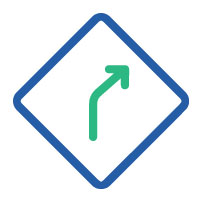Looking to increase your sales in the near future? Then you probably know you might also need to increase internal resources, including equipment, staff or inventory. The problem is, it’s almost never a one-to-one increase or even a simple proportion. This is especially true for companies that provide a product or service that has to be maintained long-term. When you’re looking to scale for the future, you need to consider the time and resources it takes to continue to serve your existing customers while adding new clients to your list.
A VERY BASIC EXAMPLE OF SCALE CALCULATIONS
It takes a certain amount of time and resources to make a salend that’s true no matter what product or service you provide.
Consider this very simple sample model:
- For each sale, a company estimates it takes 22 hours of total labor hours. That includes marketing, sales, customer service, delivery or installation.
- If a company makes 100 sales a month, that’s 2,200 hours.
- Assuming employees work 40 hours per week, you can estimate that you need around 14 employees to support those sales.
This is a simple example, but you can see how companies might begin to use data to estimate what type of resources they need to grow. Based on the numbers above, if the company wants to make 200 sales a month, they need 14 more employees (or a staff of 28).
INTEGRATING THE MAINTENANCE PLANNING COMPONENT
Obviously, there are typically more factors at play when you’re developing a growth plan — and that’s certainly true for many field service organizations. If you provide maintenance plans or guarantees, then it’s not all about how many new customers you can serve, but about how many new customers you can add to the list you already serve.
Look at those very basic calculations with only this one factor added in.
- For each sale, it takes 22 hours of total labor hours.
- But it also takes an average of 1 hour a month in maintenance labor hours to maintain every contract, product or sale.
- If a company makes 100 sales a month, that’s 2,200 hours just for the sales, but 100 hours added to the resource needs for every future month those clients or contracts are being maintained.
- Assume that a contract lasts for one year and the company starts from scratch.
- In January, they need 14 employees to make the sale. If sales are constant (meaning there are 100 new sales each month), the maintenance hours each month grow:
- February: 100
- March: 200
- April: 300
- May: 400
- Until December, which would require 1,100 maintenance hours. When you combine that with the 2,200 hours required just to complete those sales, the company now needs around 20 employees instead of 14.
That increase in resources is required even without scaling up the sales. If the company wants to increase sales by 10 percent every month, by December, they would be selling 285 units and maintaining 2138 units. That’s more than 8,400 labor hours or around 53 employees minimum.
PUTTING TECHNOLOGY TO WORK IN MAINTENANCE PLANNING
Despite the amount of math above, those are very simple models.
In a real situation, you would likely have dozens of other factors contributing to resource and scheduling needs as you grow. Which is why it’s important to implement the right technology. The right field service scheduling software lets you understand exactly how to manage your staff and time day to day. But it also provides important insights into what you may need as you grow.
By using solutions that help you solve problems as they occur and make complex planning easier, you can reduce the likelihood of growth errors.

HIRE AND TRAIN AHEAD OF THE CURVE
Businesses that know exactly how their growth plans and maintenance needs impact future resource requirements can plan ahead. That means hiring the technicians required to service maintenance needs and training them before you hit critical capacity.
It might seem counterintuitive to hire before you need the workers, but proactive management of the workforce comes with benefits such as:
- An increased ability to control overtime and related expenses.
- Less burnout and stress for existing staff members, which leads to better morale and lower attrition rates.
- Having the right number of people to do necessary work, which reduces careless errors from rushing through jobs.
It’s important to remember that in a modern world running on data, some of the best processes integrate human and computer input in a seamless package. The right maintenance scheduling solution helps you do that by coupling what you and your team know about the business, products and customers with your scheduling software’s ability to consider large amounts of data from these sources. The result is a workable schedule that you can quickly tweak and publish on a daily or weekly basis.

MAKING DATA-BACKED GROWTH DECISIONS
When you implement resource management and scheduling software, you’re better able to keep tabs on a large amount of data related to your business processes. In some cases, that can mean uncovering opportunities for huge savings.
When it comes to the future, it means making smarter decisions about how and when to grow. For example, if it takes an untenable amount of hours to maintain certain types of contracts, you may want to try streamlining maintenance planning and processes before you attempt to aggressively grow that line of business. As you saw with the numbers above: labor related to old contracts can quickly become a big draw on your resources as you scale.

MAKE OUTSOURCING DECISIONS (AND MANAGING THOSE PROCESSES)
Whether or not to outsource certain elements of work is a common decision that needs to be made as businesses scale. If you can’t streamline processes to reduce the labor demands of maintenance, you may be able to reduce overall business costs and strain by outsourcing some of that work to contractors.
The downside is that you add a whole new level of management to the mix, making it even more important to have a strong system in place to ensure your customers are being taken care of.
One mistake businesses of all types make when scaling up is to push for growth in spite of everything else. But your existing customers are the foundation upon which you build, and you must do the work and analysis to ensure you can continue to serve them well even while you add new clients to the fold. Visual Planning’s intelligent business solutions can help you do that.
Manale is a passionate about digital marketing. She joined STILOG I.S.T in 2018.
She brings SEO & SEA expertise, email marketing and creative content marketing to create a great brand experience for Visual Planning customers.



